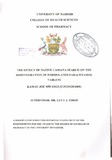| dc.description.abstract | The project involved the use of extracted cassava starch from raw cassava tubers as a
disintegrant in the manufacture of tablets. However, there was also manufacture of tablets
using industrial corn starch. The tablets obtained were tested for comparison. Other physicochemical
tests were conducted on the locally acquired cassava starch.
The extracted cassava starch was also subjected to tests such as solubility, cyanogenic
glycoside, iodine, tannin, angle of repose, bulk density, swelling capacity, and moisture
content. The starch was confirmed and found to be insoluble in water and ethanol,
cyanogenic glycosides were present, no tannins were present and bulk density, swelling
capacity and moisture content results were recorded accordingly.
Wet granulation was then done to make granules that would be used to make the tablets.
Small granules were then formed by passing them through different SIeves
viz:710um,500um,355um,250um,180um,125um.The granules weights were then recorded
and results tabulated. The granules were then used to make corn and cassava tablets for
comparison tests.
The comparison of the tablets formed by the cassava and corn starches was then done in the
form of different tests done viz; disintegration, mechanical strength, friability, hardness and
uniformity of weight. This tests were done following relevant Standard Operating Procedures
as they were stipulated.
The use of locally acquired starches such as cassava was a noble approach however the rates
of disintegration, friability, mechanical strength and other tests done on the tablets showed
corn starch was the preferred disintegrant and that it was the disintegrant of choice as it
served as a staple food for the country thus its availability. A risk of using cassava was
evident due to it containing cyanogenic glycosides as evidenced by the test.
The tablets seemed not to pass friability and disintegration tests as the compression was not
adequate during tableting.Most tablets passed the uniformity of weight test.Deviations from
the mean weight were presented in table format. | en_US |
| dc.description.department | a
Department of Psychiatry, University of Nairobi, ; bDepartment of Mental Health, School of Medicine,
Moi University, Eldoret, Kenya | |

